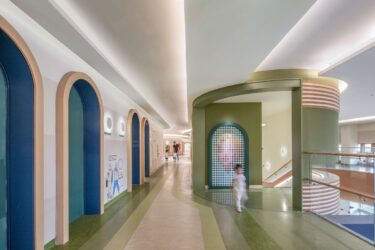
Kokaistudios designed the EYAS Kindergarten as an innovative early-years educational facility built upon values of creativity, community and cohesion.
Kokaistudios has designed Eyas Kindergartenas a children’s interactive wonderland. Every design decision was influenced by the studio’s child-centred approach; from the furnishings and fixtures to signage and storage, the result is not simply a space that facilitates the learning process but seeks to actively improve it.
Story continues below advertisement
Sited within a dense urban landscape and surrounded by residential towers, Kokaistudios were challenged with optimising natural light and the wholesale reconfiguration of the internal structure. The design team rearranged the interior space with an open layout and dynamic circulation. The floorplan at EYAS Kindergarten features nine standardised classrooms alongside specialised spaces for dance, music, art, cookery and technology, each with a playful and engaging design that fosters a stronger bond between student and subject.
Related: Nature’s school by Vijay Gupta Architects
Linear circulation and unitary levels are eschewed in favour of varied volumes and playful exploration points. The punctuation of circular elements, from tables and chairs to reading trees and the floorplan, enhances a communal continuity at every turn and removes dangerous sharp edges, while the curving walls accommodate niche storage solutions.
Story continues below advertisement
The design scheme combines utility, learning and recreational space across two floors linked by a statement central staircase with an incorporated welcome desk and eye-level viewing strip.
The corridors have been replaced with internal social spaces and interlinking indoor playgrounds. An upper-floor playground is a place for the kids to look down on the main staircase and the double-height ceiling; it encourages them to go and explore the space and the different mediums of art.
Story continues below advertisement
Meanwhile, the colour palette has been chosen for its psychological properties – yellow, orange and green all play a role in improving reading and numerical comprehension – and their presence in a selection of iconic paintings.
Design features and considerations have been added to stimulate the children’s thinking outside of classroom learning. A De Stijl-inspired clock face greets students as they enter the building, while dance room signage on the second floor mirrors the figures from Degas’ seminal The Dancing Class. The signage has been designed with simplified typography that forms the bulk of the wayfinding, though a selection of visual subject representations prompt interpretation and a deeper quality of engagement.
Kokaistudios
kokaistudios.com
Photography
RAWVISION studio
Next up: Pillars of workplace design and campus master-planning in India